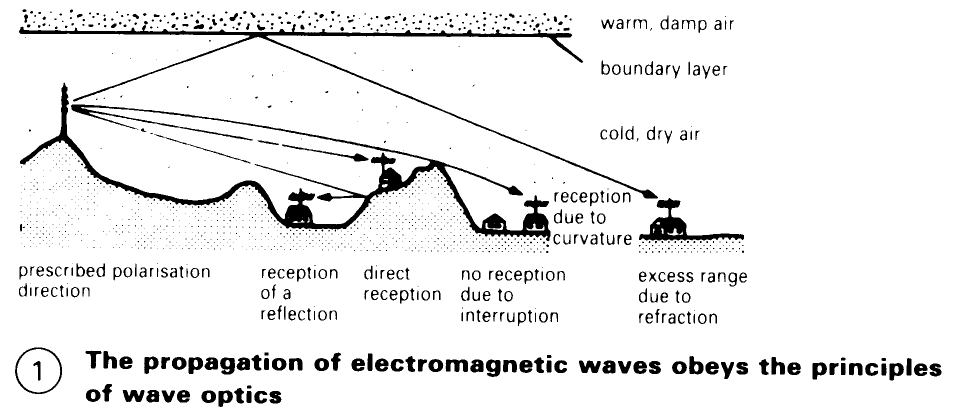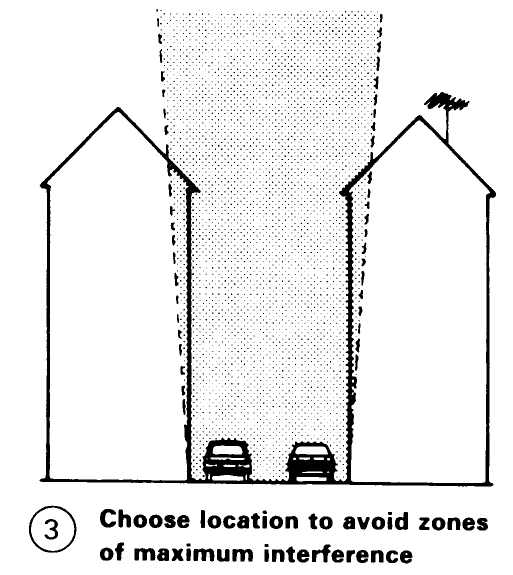Protection from Lightning. Aerials
Around a latitude of 50°, lightning strikes the ground approximately 60 times (and cloud 200-250 times) per hour of storms. Within a radius of 30m from the point of strike (trees, masonry work, etc.), persons in the open air are in danger from stepped voltages and, consequently, should stand still with their feet together.
The damage liable to be inflicted on building constructions is due to the development of heat. Ground strikes heat and vaporise the water content to such a degree that walls, posts, trees, etc., can explode due to the overpressure generated wherever dampness has collected. Roof structures, dormer windows, chimneys and ventilators should receive particular attention in lightning protection systems and should be connected into the system.
A lightning protection system consists of lightning rods, down conductors and earthing devices. In essence, a lightning protection system represents a 'Faraday cage', except that the mesh width is enlarged. Also, initial contact points (or lightning rods) are fitted, so that the point of impact of the strike can be fixed. Thus, the lightning protection system has the function of fixing the point of lightning strike by means of the air terminals and ensuring that the structure lies within a protected zone.
The air terminals or lightning conductors are metal rods, roof wires, surfaces, roof components or other bodies. No point on the roof surface should be further than 15m from an air terminal device.
On thatched roofs, due to the danger of ignition resulting from the corona effect, metal bands (600mm wide) should be laid over the ridge on wooden supports - (8). When flowing, a lightning current can reach 100 000 A and, due to the earthing resistance, a voltage drop of 500 000 V occurs. In the instant of the strike, the entire lightning protection system, and all components which are connected to it by metal parts, are subjected to this high potential.

Equipotential bonding is the very effective precaution of connecting all large metal components and cables to the lightning protection system.
The earthing system is required to conduct the lightning current rapidly and uniformly to earth; this is achieved by using uninsulated metal bands, tubes and plates, pushed so deep into the ground that a low resistance to ground dissipation is attained – (12) – (13).

The level of earthing resistance depends on the type of ground and the dampness – (11). A distinction is made between deep earthing electrodes and surface earthing electrodes. Surface earthing electrodes are designed either in a ring shape or in a straight line; preferably, they are embedded in the concrete of the foundations – (12) – (13).

Rod earthing electrodes (round rods or rods with an open profile) are contained in a tube driven into the ground. Earthing electrodes inserted to a depth of more than 6m are called 'buried earth electrodes'. A star type earth electrode is one consisting of individual strips which radiate out from a point or from an earthing strip. On roofs, walls, etc., clad in aluminium, zinc or galvanised steel – (1) - (6) bare or galvanised copper conductors are not permissible; instead bare aluminium conductors or galvanised steel conductors should be used.



Aerials. Aerials affect the appearance of cities, and, when close together and in the same line of sight to the transmitter, they are subject to mutual interference. Communal aerials can solve these problems, but planning of these is needed at the initial stage of construction. Provision should be made in the basic construction of buildings for the space requirement and installation of facilities for amplifiers to oppose the current drop in the cabling and to provide adequate earthing - (5) – (6) plus the additional equipment needed to earth the lightning protection system p.138.

For connections to water pipes, care is needed to avoid short circuiting water meters (6). Aerial performance is strongly influenced by the surroundings - (1) e.g. trees extending above the aerial height - evergreens, in particular - and overhead high voltage power lines. Good reception requires alignment (polarisation) with the nearest transmitter - the best position being when the aerial is in line of sight with the transmitter.


Short waves do not follow the curvature of the Earth and ultra short waves only partially - a portion reaching the troposphere is reflected, so that TV reception may be possible even when the transmitter would not normally be of sufficient strength to reach the receiver. Various aerial shapes are available. Basic fundamentals should be observed - (3). Aerials under the roof, intended for the UHF range, provide low-quality reception. In the VHF range, the drop in reception relative to outside aerials is only about half as great. Room aerials (auxiliary aerials) are many times weaker.

One aerial should serve for the reception of long, medium, short, ultrashort waves and for a number of TV channels - with corrosion protection for long life. For aerial mast systems, reference should be made to the appropriate regulations – (4). Normally, the aerial mast is inserted into the roof framework, on a support member with a span of at least 0.75 m. On flat roofs, attachment to an outer wall is a practical proposition. Attachment to a chimney which is in use is disadvantageous due to the danger of corrosion.
Aerials must not be mounted on roofs made from easily combustible roofing materials, e.g. straw or reeds; instead, mast or window- mounted aerials should be provided. Aerials are not required for wide band cable systems. In addition to the point of connection (to household), space should be provided in the cellar for the amplifier with mains connection.

Date added: 2023-01-01; views: 894;
